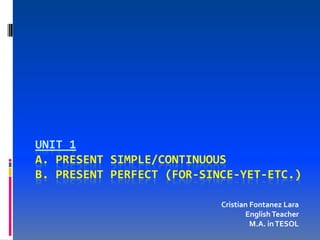Unit 1
•Descargar como PPTX, PDF•
1 recomendación•711 vistas
Present simple and continuous, Present Perfect
Denunciar
Compartir
Denunciar
Compartir

Recomendados
Más contenido relacionado
La actualidad más candente
La actualidad más candente (20)
Destacado
Destacado (20)
Present Perfect Simple And Present Perfect Continuous

Present Perfect Simple And Present Perfect Continuous
Similar a Unit 1
Similar a Unit 1 (20)
Cuál es la diferencia entre PRESENT SIMPLE y PRESENT CONTINUOUS.docx

Cuál es la diferencia entre PRESENT SIMPLE y PRESENT CONTINUOUS.docx
AMERICAN HEADWAY 3 VERSION 2003. Gramatica del libro.

AMERICAN HEADWAY 3 VERSION 2003. Gramatica del libro.
Más de cristian fontanez
Más de cristian fontanez (20)
Último
Último (20)
Novena de Pentecostés con textos de san Juan Eudes

Novena de Pentecostés con textos de san Juan Eudes
Louis Jean François Lagrenée. Erotismo y sensualidad. El erotismo en la Hist...

Louis Jean François Lagrenée. Erotismo y sensualidad. El erotismo en la Hist...
PP_Comunicacion en Salud: Objetivación de signos y síntomas

PP_Comunicacion en Salud: Objetivación de signos y síntomas
Tema 19. Inmunología y el sistema inmunitario 2024

Tema 19. Inmunología y el sistema inmunitario 2024
SESION DE PERSONAL SOCIAL. La convivencia en familia 22-04-24 -.doc

SESION DE PERSONAL SOCIAL. La convivencia en familia 22-04-24 -.doc
PINTURA DEL RENACIMIENTO EN ESPAÑA (SIGLO XVI).ppt

PINTURA DEL RENACIMIENTO EN ESPAÑA (SIGLO XVI).ppt
Prueba de evaluación Geografía e Historia Comunidad de Madrid 2º de la ESO

Prueba de evaluación Geografía e Historia Comunidad de Madrid 2º de la ESO
Prueba de evaluación Geografía e Historia Comunidad de Madrid 4ºESO

Prueba de evaluación Geografía e Historia Comunidad de Madrid 4ºESO
ACERTIJO LA RUTA DEL MARATÓN OLÍMPICO DEL NÚMERO PI EN PARÍS. Por JAVIER SOL...

ACERTIJO LA RUTA DEL MARATÓN OLÍMPICO DEL NÚMERO PI EN PARÍS. Por JAVIER SOL...
TEMA 14.DERIVACIONES ECONÓMICAS, SOCIALES Y POLÍTICAS DEL PROCESO DE INTEGRAC...

TEMA 14.DERIVACIONES ECONÓMICAS, SOCIALES Y POLÍTICAS DEL PROCESO DE INTEGRAC...
ACRÓNIMO DE PARÍS PARA SU OLIMPIADA 2024. Por JAVIER SOLIS NOYOLA

ACRÓNIMO DE PARÍS PARA SU OLIMPIADA 2024. Por JAVIER SOLIS NOYOLA
Unit 1
- 1. UNIT 1 A. PRESENT SIMPLE/CONTINUOUS B. PRESENT PERFECT (FOR-SINCE-YET-ETC.) Cristian Fontanez Lara English Teacher M.A. in TESOL
- 4. A. Present simple vs. continuous 1. Usamos el presente simple para hablar de hábitos regulares. What do you do on a rainy day? (¿Qué haces en un día lluvioso?) 2. También se utiliza para hablar de hechos : cosas que son siempre verdaderas. The school term finishes in June. (El semestre escolar termina en Junio)
- 5. 3. Usamos el presente continuo para acciones o situaciones temporales ocurriendo al momento del habla. Is your sister working at the moment? (¿Está tu hermana trabajando ahora?) 4. Usamos el presente continuo para hablar de situaciones que cambian o tendencias. Are boys spending more than girls these days? (¿Están los niños gastando más que las niñas estos días?)
- 6. 5. Los verbos de opinión normalmente son usados en presente simple. Por ej. Think, like, prefer. I prefer water to fizzy drinks. (Prefiero el agua en vez de las bebidas.)
- 7. Some practice? Use present simple or continuous. Use: feel, prefer, tend, spend, joke, have, join.ç 1. These days I _______________ less and less time with my family. 2. Boys ______________ to spend more time watching TV than girls.
- 8. Some practice? Use present simple or continuous. Use: feel, prefer, spend. 1. These days I ‘m spending less and less time with my family. 2. Boys prefer to spend more time watching TV than girls.
- 10. B. Present perfect (for, since, etc.) Usamos el presente perfecto para hablar de acciones en un período de tiempo que comenzó en el pasado y continúa al presente. 1. Utilizamos SINCE para hablar del comienzo del período de tiempo (una fecha específica). I haven’t seen her since last week. (No la he visto desde la semana pasada) 2. Usamos FOR para hablar de la duración del período de tiempo. We haven’t been to the cinema for weeks. (No hemos ido al cine por semanas.)
- 11. Just/already/yet/still 1. Usamos JUST antes del verbo en participio para decir que algo ocurrió hace poco tiempo. We’ve just arrived. (Acabamos de llegar) 2. Usamos ALREADY al final de una oración o antes del participio para expresar sorpresa o dar énfasis a algo que ha ocurrido. We’ve already seen this film. (Ya hemos visto esta película.)
- 12. 3. Usamos YET al final de una oración negativa o una pregunta para enfatizar que algo no ha ocurrido . 4. Utilizamos STILL antes de haven’t o hasn’t en oraciones negativas para mostrar sorpresa cuando esperábamos que ocurriera algo pero no pasó.
- 13. Practice
